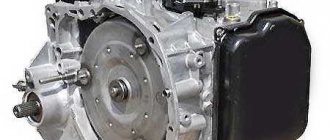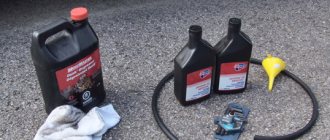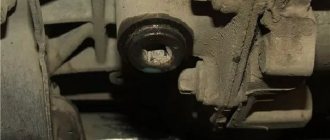09.01.2020
| (Votes: 1, Rating: 5) |
Issues discussed in the material:
- Where did the opinion come from that an oil change in a 6-speed automatic transmission is not necessary?
- Why is it important to change automatic transmission oil on time?
- Features of changing oil in a 6-speed automatic transmission
- What do professionals say about changing the oil in a 6-speed automatic transmission?
Ten to fifteen years ago, in accordance with the regulations of almost all automakers, changing the oil in automatic machines was mandatory. And today manufacturers claim that there is no need for this and the filled liquid is enough for the entire service life of the unit. This statement worries car owners, especially newbies, who are lost in a sea of information, not understanding whether an oil change in a 6-speed automatic transmission is necessary or not.
Of course, it is necessary to change the oil, but it is important to do this procedure correctly. Today, there are many mechanics at car services who, instead of a complete oil change, do a partial one, so now we will figure out how to properly change the oil in an automatic transmission.
Where did the opinion come from that an oil change in a 6-speed automatic transmission is not necessary?
In order for the lubricant to perform its function as efficiently as possible, a couple of decades ago car manufacturers stated that an oil change in an automatic transmission with a 6-speed automatic was necessary every 30,000–60,000 km. However, modern cars are equipped with boxes with electrical control systems, and the transmission adapts much better to driving conditions and the properties of the lubricant used.
Some leading automakers around the world have begun to claim that an oil change in a 6-speed automatic transmission is no longer required. Moreover, this recommendation was the first to be given, and then competing companies - manufacturers of German cars, BMW and Audi.
At that time, a five-speed gearbox of the 722.6 series was installed, which they independently developed for their cars. Audi and BMW did not create revolutionary gearboxes. These cars were equipped with 6-speed ZF gearboxes, which were marked that the lubricant did not need to be changed during the entire life of the car. However, the entire German troika indicated in fine print on the automatic transmission that if the car is operated in difficult conditions, an oil change is still needed.
The auto industry always follows the example of flagship companies, so other automakers began to use this innovation. Now it was recommended to change the oil in a 6-speed automatic transmission less often. Is it good or bad? To answer this question, let's compare how reliable gearboxes were in the early and late nineties of the last century. It has been proven through many examples that changing the oil of a 6-speed automatic transmission must be done, strictly adhering to the regulations and without waiting for the automatic transmission to fail.
Today, both Mercedes, as well as BMW and Audi, indicate in the car’s passport the period when the lubricant in the gearbox should be replaced. For example, if previously it was indicated on the automatic transmission 722.6 BMW that there is no need to change the working fluid, now on car models of the last 5 years of production, which have exactly the same gearbox, it is recommended to change the oil in the automatic transmission after 50,000 km (or every 3 years ). If the automatic is new 7-speed 722.9, then after 125,000 kilometers (every 5 years).
Please also pay attention to the fact that almost all official dealerships will recommend that you change the oil in a 6-speed automatic transmission every 60,000–80,000 km, without taking into account what is said in the car’s operating instructions.
However, if you compare the properties of a new lubricant and one that has been used for a long time without replacement, the differences will be significant. Despite the fact that a 6-speed automatic transmission may be in full working order, problems due to old oil will still appear. The best outcome is that the machine will have to be adapted to the new lubricant. Or the gearbox may become unusable altogether.
Which Shell oils are suitable for cars with automatic transmission?
- Shell Spirax S5 ATF X. Synthetic-based transmission fluid for cars and trucks with automatic transmissions. Meets approvals: Aisin JWS 3309, Allison C-4, Dexron (I-III), Ford MERCON, Ford MERCON V, JASO 1-A, JASO 2A-02, Toyota T-III, Toyota T-IV.
- Shell Spirax S6 ATF ZM. A synthetic product developed for trucks and buses. Received approval from ZM. Extends the oil change interval to 150 thousand km.
- Shell Spirax S6 ATF A295. Fully synthetic fluid, suitable for heavy-duty vehicles. Meets Allison TES-295 specification. Has a stable viscosity class throughout the entire period of operation.
- Shell Spirax S6 ATF VM Plus. Premium ATP fluid. The oil maintains acceptable viscosity even at extremely low temperatures. Complies with ZF TE-ML 03D-09, MB 236.9, MB 238.22, Voith H 55.6336, Section 1.3 and others.
- Shell Spirax S4 ATF HDX. Oil for trucks and some passenger automatic transmissions. The advantages of the product are: a long service life between replacements and excellent fluidity at low temperatures.
- Shell Spirax S2 ATF AX. Used in transmissions and hydraulic boosters. Has a long service life. Approved by Mercedes, Ford, Renk, MAN automakers.
- There are other oils from the Shell Spirax series for cars with automatic transmissions, which can be found on our website.
Why is it important to change automatic transmission oil on time?
If you regularly change the oil in a 6-speed automatic transmission, you can increase its service life and also prevent various breakdowns from occurring. For example, all elements of the machine are in perfect condition and not damaged. At the same time, due to old lubricant, the valve body and solenoids became clogged. The box jerks during shifts. If you change the oil in such a 6-speed automatic transmission, you will be able to remove contaminants, because they will simply be washed out.
This method of box repair is recommended by many car manufacturers. So, the recommendations indicate that if the automatic transmission is malfunctioning, extraneous sounds appear, the oil should be changed. Instead of factory lubricant, you need to use a working fluid with slightly different properties. However, when the transmission failure is serious, this procedure is unlikely to eliminate the problem without expensive repair work.
What volume should be in the checkpoint
Cars of different brands and models differ in their design, and accordingly there are differences in the structure of the boxes. Different models of different cars use different amounts of oil. Find a clear answer to the question “how much oil should be in the box?” You can only read the manual or operating instructions for the car, or find out this at a service station. When replacing, it is worth remembering that there are differences in their compositions and types. You should always buy with a small reserve (0.5 - 1 liter) so that you can top up if there is a leak during replacement.
There are three types for gearbox:
- synthetic;
- semi-synthetic;
- mineral.
Synthetic
It is considered the most modern, it is well cleaned and enriched with additives that maximally protect mechanisms from corrosion. It is mainly poured into automatic transmissions or manual transmissions of high-end cars. In automatic transmissions it should be changed every 50 thousand km. mileage In mechanical ones - every 60-70 thousand km. mileage In terms of cost, this type is the most expensive, but also the best. But this does not mean that it can be poured into the boxes of old cars: they may simply not be designed for this!
Semi-synthetic
Semi-synthetic is used in most budget foreign cars, in the entire range of the 10th AVTOVAZ family (Lada Kalina, Priora). It contains a number of chemical additives that protect gears, synchronizers and other mechanical parts from wear. It is worth replacing such oil every 40-50 thousand km. mileage The biggest plus is the price-quality ratio.
Mineral
The mineral is used in axles and gearboxes of rear-wheel drive vehicles. For example, in the entire line of AVTOVAZ classics or similar cars, as well as in some trucks. The mineral one is purified less than all the others; accordingly, it degrades faster and requires replacement quite often - every 35-40 thousand km. mileage
Features of changing oil in a 6-speed automatic transmission
The ideal option is if the service book fully reflects the vehicle’s maintenance history, and it was filled out by professional mechanics and experienced car owners. Changing the automatic transmission oil on a 6-speed automatic must be carried out within the period strictly established by the automaker or a little earlier. The fact is that on modern cars it quickly becomes dirty and changes its properties due to the fact that gas turbine engine blocking linings are used.
If your car has a preselective type gearbox, for example DSG DQ250 and DQ500, then on them the wet clutch operates in an oil bath. Naturally, a large amount of wear products penetrates into the lubricant. Due to the design features of the automatic transmission, as well as low pressure, the filter elements are not capable of 100% retaining foreign matter.
Based on this, it is worth noting again:
- changing the oil in a 6-speed automatic transmission must be done within the period specified by the manufacturer;
- New lubricant must be refilled more often than indicated in the regulations. It is recommended to do this every 30,000–40,000 km.
However, in practice this rarely happens. In reality, especially if the car remains with one owner throughout its entire service life, and he carries out scheduled maintenance (according to the specifications established for difficult road and climatic conditions), then even not the most reliable gearboxes continue to function properly. But if the owner of the car tries to save money, is cunning and does not want to spend money and time on servicing a 6-speed automatic transmission, then the automatic transmission quickly fails.
How is automatic transmission oil changed on a 6-speed automatic? There are several ways: displacement, partial or complete replacement.
The main advantage of the automatic ECU is that it is possible to diagnose the transmission without the need to dismantle and disassemble it. Of course, this procedure does not help in all cases, but most often, using a special scanner at a dealership, it will be possible to identify automatic transmission faults. To do this, you need to connect the device to the ECU. In the case when the machine is in normal condition, does not twitch, does not slip, and no errors are detected, it is quite possible to return the box to the normal maintenance and oil change intervals.
The ideal option is to do a complete oil change in a 6-speed automatic transmission using the displacement method or pumping. That is, the used lubricant will be removed and a new one will be poured in instead. Then the mechanic will reset the adaptation using a special scanner.
Despite conflicting reviews from car owners, it is precisely changing the oil in a 6-speed automatic transmission using the displacement method that helps keep the box in good condition, of course, if it was functioning without problems before.
In this case, after filling in new lubricant, it will work even better. In other conditions, if the machine was already faulty, changing the oil will not help extend its life.
There are often cases when a car owner decides to change the oil only after serious damage to the transmission occurs. In this situation, radical action is not needed. How to change the oil in a 6-speed automatic transmission if it is faulty? Let's use a different method. Experts do not recommend completely changing the lubricant; a partial replacement is needed here. This way some of the lubricant is removed (without using a pump). The old working fluid is diluted with a new one, and after a short period of time this manipulation is carried out again.
We recommend
“How to pour oil into a box: automatic and manual” Read more
Why do you need to act this way? The fact is that if a completely new lubricant is poured into a faulty 6-speed automatic transmission, the properties of which are different, the operating conditions of the machine will change. The new oil contains a huge amount of detergent additives, so the hydraulics will immediately clog.
To change the lubricant in this way, you do not need a special scanner or other expensive equipment. Therefore, in many small car services, changing the working fluid is done this way. Please note that the myth that the method of changing oil in a 6-speed automatic transmission is unacceptable is spread by employees of small service centers and their clients. It is clear that they say this simply to intimidate car owners and attract as many new visitors as possible.
After the lubricant has been partially replaced, you should pay attention to how the machine behaves. If it starts to work better, then you can replace some more oil. Then it is permissible to apply the displacement method. However, if the box begins to feel worse, you should wait a while.
Note! Partial refilling of new lubricant is acceptable in situations where the machine is not fully operational. When the oil in a 6-speed gearbox was changed strictly within the time limits specified by the manufacturer, the displacement method should be used.
If the working fluid in a 6-speed automatic transmission is so dirty that it clearly indicates a breakdown, and the automatic transmission has been malfunctioning for a long time, the lubricant should be replaced differently. Especially if the car owner does not want to spend money on a major overhaul of the machine immediately after filling in new oil. Then you need to not only replace the working fluid, but also clean the valve body, test it, and install new gaskets.
These manipulations can already be attributed to repair work. However, it is the filling of new lubricant, as well as the elimination of the harmful replacement factors, that will have a positive effect on the functioning of the machine.
Typically, this method of changing oil in a 6-speed automatic transmission is used if the automatic transmission is located longitudinally, with the valve body located at the bottom. In this case, you can quickly remove the gearbox housing, as well as the valve body. Therefore, the cash costs for this work will not be so large. Usually, after new grease is added and the box is cleaned, it will begin to work properly. However, it may also happen that the changes will be completely unnoticeable or the machine will stop functioning completely.
Purpose of gearbox lubrication
The gearbox is the largest gearbox in a car transmission. Thanks to a stepwise change in the gear ratio, the driver has the opportunity to combine two ranges - wheel speed in the range of 50 - 1500 min-1 and engine crankshaft speed 800 - 8000 min-1. Depending on the type of transmission, the gears of the gearbox are lubricated in the following ways:
- cylindrical - oil bath with immersion of low-speed wheels to a third of the diameter, high-speed wheels to a depth of h = 5m;
- bevel - crankcase lubrication with the entire lower tooth of the gear immersed in oil;
- planetary - the high-speed stage is immersed in an oil bath to the entire depth of the inner tooth.
Spur gear box
Planetary gearbox
Manual transmission drain hole
Information about what kind of oil to pour into a manual gearbox is relevant when repairing components and assemblies associated with the gearbox (for example, replacing the clutch) when the life of the lubricant itself is exhausted.
Transmission filler hole
The gearbox traditionally belongs to units with high operating loads. In addition, passenger car manufacturers use different gear designs in different car models, so the frequency of oil changes in manual transmissions is required in the manual.
The user should note that changing the oil in a manual transmission has nuances:
- with a minimum maintenance budget (filling with mineral oil), operating costs will increase as the lubricant life will decrease;
- when purchasing expensive synthetics, on the contrary, the initial investment will increase, but the service life of such oil is longer and the replacement frequency is greater than in the previous case;
- Semi-synthetics have a rational ratio of lubricant quality and cost.
Mineral oil
Synthetic oil
Semi-synthetic oil
Thus, oil in a manual transmission solves several problems simultaneously:
- lubrication and reduction of friction of gears;
- heat removal from friction pairs;
- removal of metal filings from the surfaces of wear parts of the gearbox;
- protection of gears and gears from oxidation and corrosion.
The cost of 3 liters of gear lubricant is significantly lower than replacing a manual transmission or breaking a gear while driving.
What do professionals say about changing the oil in a 6-speed automatic transmission?
1. “Contraindications” for changing the oil
“It would seem that something bad could happen if you change the oil in a 6-speed automatic transmission? However, the result may be negative. Elements of the machine, such as clutches, wear out greatly even during quiet driving without increased loads. Over time, wear products accumulate inside the gearbox hydraulic system. As soon as the new lubricant is poured (and it has high cleaning properties compared to the old one), the deposits will be washed away and get into the valve body and solenoids. As a result, they become clogged. The box will begin to twitch and switch with delays.
This happens most often on cars with high mileage, especially if no one has changed the working fluid in the machine. Also, you should not completely change the oil in faulty 6-speed automatic transmissions. Indeed, in these situations, the hydraulic system contains a huge amount of wear products. To avoid making the machine worse, simply perform the replacement using several methods.”
We recommend
“Changing the oil in a Toyota Camry automatic transmission: a detailed guide” More details
2. Pros and cons of partial and complete oil changes
“Each method of changing the working fluid has its own advantages and disadvantages.
First, about hardware replacement.
Advantages:
- completely new lubricant is poured;
- fresh working fluid flushes the entire system, as well as the valve body;
- you will be able to monitor how clean the oil comes out of the machine.
Flaws:
- high price for the procedure;
- one and a half volumes of new lubricant will be required;
- difficult work with tubes, connections will be broken;
- the auto mechanic must have experience in performing replacements using a special device;
- It is not possible to carry out a hardware lubricant change on every machine.
Now regarding the partial filling of new lubricant.
Advantages:
- you can perform the procedure without using special equipment, but you will need a device for filling new working fluid through the side hole (if there is no dipstick);
- a smaller volume of lubricant will be required for replacement, the cost of work is also lower;
- there is no need to penetrate into the design and system, therefore the risk of harming the machine is minimized.
Flaws:
- This method allows you to partially replace the working fluid.
At first glance, there is nothing complicated. Two options: a complete oil change in a 6-speed automatic transmission - you will spend more money on it, because you need to buy oil and also pay a technician; simplified change of working fluid - no special equipment is needed, you will save on the procedure, you will also need less oil. This type of oil change can be done at every car service center that has a lift.”
3. Tips for changing the oil
“Option one – we partially change the lubricant, it will take 4–4.5 liters. We remove the old working fluid from the crankcase and fill it with new one.
Option two - we completely change the working fluid without a device, you will need 8 liters, drain it from the radiator hoses.
Option three - completely change the lubricant on the pressurized device. The cost of the procedure is quite high; about 12–18 liters will be needed. This method will not work if the filter element on the machine is not changed, and the lubricant is dirty. After all, contaminants will settle in the filter, in addition, sediment will rise from the machine itself. In this case, it is better to replace the working fluid in two stages, with an interval of 500 kilometers between them.
When new lubricant is added, you need to reset the machine’s adaptation:
- The box must be warmed up, you need to stop and press the brake.
- We move the selector of the 6-speed automatic transmission for 3 seconds. to position “N”, then for 3 seconds. to position “D”, a total of 10 switches will be required.
- Now you need to reach a speed of 80 km per hour, the automatic transmission must shift all gears up, with shifts occurring up to 2 thousand revolutions per minute.
- We brake carefully, the automatic switches all gears down.
That's it, adaptation is reset.
What lubricant can be used to replace a 6-speed automatic transmission: (you can use any ATF SP-IV):
- Lubricant for 6-speed automatic transmission (A6GF1) Hyundai ATF SP-IV (1l) - 04500-00115.
- Lubricant for 6-speed automatic transmission (A6GF1) RAVENOL ATF SP-IV (4 l) - 4014835714090.
- Lubricant for 6-speed automatic transmission (A6GF1) ZIC ATF SP-IV (4 l) - 162646.
What consumables will be required (if you are filling in working fluid for the first time, you can do without them):
- Washer-elastic control plug for 6-speed automatic transmission (A6GF1) - 45285-3B010.
- Crankcase drain plug washer for 6-speed automatic transmission (A6GF1) - 45323-39000.
- Oil filter for 6-speed automatic transmission (A6GF1) - 46321-26000 (it is necessary if you plan to repair the automatic transmission).”
4. Oil to change
“Today you can find a huge number of substitutes for original branded oils on sale. What is their difference? They meet the requirements and specifications, but may not fit the factory settings for the 6-speed automatic transmission in your vehicle. For example, if a lubricant is made from an inexpensive base, as well as additives, when heated, it expands in volume 2 times more than the original oil. If the volume of working fluid increases significantly during the hot season, the box will not fail. However, if lubrication levels decrease in winter, oil starvation will occur.
If you are going to purchase a substitute, you should choose a product from a reliable manufacturer. No need to buy the cheapest lubricant. Also, the substitute must meet a certain standard, for example Dexron III or Dexron IV; it is not recommended to choose universal substitutes. The lubricant must be 99.9% identical to the original oil. After all, it was created for the specific specifications of a certain car model and automatic transmission.
Special requirements for transmission fluid
- Compliance with international standards. Automatic transmission oils do not have strict requirements from European and American organizations. However, they meet the standards of car brands. The Toyota automaker has specifications T, T-III, T-IV, WS.
- General Motors provides fluid groups DEXRON II, DEXRON III, DEXRON IV.
- Mitsubishi and Hyundai Motor Group share products for automatic transmissions SP-II, SP-III, SP-IV, Red-1.
! Of course, automatic cars require semi-synthetic and synthetic products.
Oil injection from below
If your transmission has neither a dipstick nor a filler neck, then a completely logical question appears in your mind: “Where should I fill the oil then?”
We will probably disappoint you - pumping oil can only be done through the drain hole using an oil pump, since the liquid will need to be delivered under upward pressure. This transmission layout is the most difficult to maintain on your own. It is strongly recommended that you contact a specialized service. A striking example of such a box is the Mercedes “five-speed” 722.6, which has already been mentioned - in its case, the oil is drained and filled through the drain neck at the bottom of the transmission. Initially, this transmission, like many others, was positioned by the concern as maintenance-free, but later Mercedes established a maintenance schedule of 60 thousand kilometers.











